Related Research Articles

Oil painting is the process of painting with pigments with a medium of drying oil as the binder. Commonly used drying oils include linseed oil, poppy seed oil, walnut oil, and safflower oil. The choice of oil imparts a range of properties to the oil paint, such as the amount of yellowing or drying time. The paint could be thinned with Turpentine. Certain differences, depending on the oil, are also visible in the sheen of the paints. An artist might use several different oils in the same painting depending on specific pigments and effects desired. The paints themselves also develop a particular consistency depending on the medium. The oil may be boiled with a resin, such as pine resin or frankincense, to create a varnish prized for its body and gloss. The paint itself can be molded into different textures from the plasticity that it contains. Before oil painting was fully discovered egg tempera was commonly used. Tempera did not have the flexibility in pigment that oil paints provided.

Paint is any pigmented liquid, liquefiable, or solid mastic composition that, after application to a substrate in a thin layer, converts to a solid film. It is most commonly used to protect, color, or provide texture to objects. Paint can be made or purchased in many colors—and in many different types, such as watercolor or synthetic. Paint is typically stored, sold, and applied as a liquid, but most types dry into a solid. Most paints are either oil-based or water-based and each have distinct characteristics. For one, it is illegal in most municipalities to discard oil-based paint down household drains or sewers. Clean up solvents are also different for water-based paint than they are for oil-based paint. Water-based paints and oil-based paints will cure differently based on the outside ambient temperature of the object being painted Usually the object being painted must be over 10 °C (50 °F), although some manufacturers of external paints/primers claim they can be applied when temperatures are as low as 2 °C (35 °F).
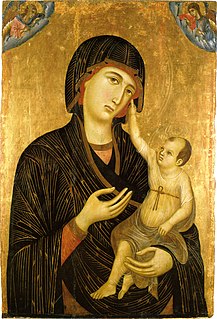
Tempera, also known as egg tempera, is a permanent, fast-drying painting medium consisting of colored pigments mixed with a water-soluble binder medium, usually glutinous material such as egg yolk. Tempera also refers to the paintings done in this medium. Tempera paintings are very long-lasting, and examples from the first century AD still exist. Egg tempera was a primary method of painting until after 1500 when it was superseded by oil painting. A paint consisting of pigment and binder commonly used in the United States as poster paint is also often referred to as "tempera paint", although the binders in this paint are different from traditional tempera paint.

Chalk is a soft, white, porous, sedimentary carbonate rock, a form of limestone composed of the mineral calcite and originally formed deep under the sea by the compression of microscopic plankton which had fallen to the sea floor. Chalk is common throughout Western Europe, where deposits underlie parts of France, and steep cliffs are often seen where they meet the sea in places such as the Dover cliffs on the Kent coast of the English Channel.

Encaustic painting, also known as hot wax painting, involves using heated encaustic medium to which colored pigments have been added for creating artworks. Molten medium is applied to a surface—usually prepared wood, though canvas and other materials are sometimes used. The simplest encaustic medium could be made by adding pigments to wax, though recipes most commonly consist of beeswax and damar resin, potentially with other ingredients. For pigmentation, dried powdered pigments can be used, though some artists use pigmented wax, inks, oil paints or other forms of pigmentation.
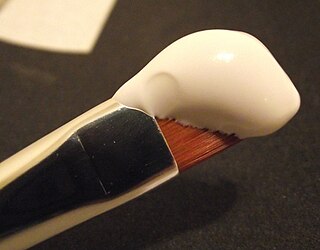
Gesso is a white paint mixture consisting of a binder mixed with chalk, gypsum, pigment, or any combination of these. It is used in painting as a preparation for any number of substrates such as wood panels, canvas and sculpture as a base for paint and other materials that are applied over it.

Gouache, body color, or opaque watercolor, is a water-medium, paint consisting of natural pigment, water, a binding agent, and sometimes additional inert material. Gouache is designed to be opaque. Gouache has a considerable history, having been used for at least twelve centuries. It is used most consistently by commercial artists for posters, illustrations, comics, and other design work.

Canvas is an extremely durable plain-woven fabric used for making sails, tents, marquees, backpacks, shelters, as a support for oil painting and for other items for which sturdiness is required, as well as in such fashion objects as handbags, electronic device cases, and shoes. It is also popularly used by artists as a painting surface, typically stretched across a wooden frame.

Whitewash, or calcimine, kalsomine, calsomine, or lime paint is a type of paint made from slaked lime (calcium hydroxide, Ca(OH)2) or chalk calcium carbonate, (CaCO3), sometimes known as "whiting". Various other additives are sometimes used.

A panel painting is a painting made on a flat panel made of wood, either a single piece, or a number of pieces joined together. Until canvas became the more popular support medium in the 16th century, it was the normal form of support for a painting not on a wall (fresco) or vellum, which was used for miniatures in illuminated manuscripts and paintings for the framing.
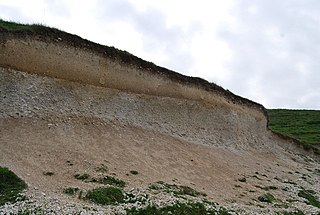
Calcareous is an adjective meaning "mostly or partly composed of calcium carbonate", in other words, containing lime or being chalky. The term is used in a wide variety of scientific disciplines.

Painting is the practice of applying paint, pigment, color or other medium to a solid surface. The medium is commonly applied to the base with a brush, but other implements, such as knives, sponges, and airbrushes, can be used.

The Entombment is a glue-size painting on linen attributed to the Early Netherlandish painter Dieric Bouts. It shows a scene from the biblical entombment of Christ, and was probably completed between 1440 and 1455 as a wing panel for a large hinged polyptych altarpiece. The now-lost altarpiece is thought to have contained a central crucifixion scene flanked by four wing panel works half its height – two on either side – depicting scenes from the life of Christ. The smaller panels would have been paired in a format similar to Bouts's 1464–1468 Altarpiece of the Holy Sacrament. The larger work was probably commissioned for export to Italy, possibly to a Venetian patron whose identity is lost. The Entombment was first recorded in a mid-19th century Milan inventory and has been in the National Gallery, London, since its purchase on the gallery's behalf by Charles Lock Eastlake in 1861.
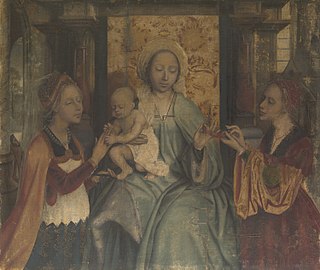
Glue-size is a painting technique in which pigment is bound (sized) to cloth with hide glue, and typically the unvarnished cloth was then fixed to the frame using the same glue. Glue-size is also known as distemper, though the term "distemper" is applied variously to different techniques. Glue-size was used because hide glue was a popular binding medium in the 15th century, particularly among artists of the Early Netherlandish period, who used it as an inexpensive alternative to oil. Although a large number of works using this medium were produced, few survive today, mainly because of the high perishability of linen cloth and the solubility of hide glue. Well-known and relatively well-preserved — though substantially damaged — the most notable examples include Quentin Matsys' Virgin and Child with Saints Barbara and Catherine and Dirk Bouts' Entombment. In German the technique is known as Tüchleinfarben, meaning “small cloth colours”, or Tüchlein, derived from the German words Tüch and Lein.
Most Tibetan Buddhist monasteries, temples and other religious structures in the Himalayas were decorated with Tibetan Buddhist wall paintings. Despite much destruction in Tibet itself, many of these survive, the dry climate of the Tibetan plateau assisting their survival, as the wet Indian climate has reduced survival of paintings from there. There are some regional differences, but the techniques described here cover the traditional wall paintings across this area. The wall paintings were executed on earthen plaster with the secco-technique. A secco-technique is a painting technique in which the pigments with their binder are employed to paint onto a dry wall.

The conservation and restoration of silver objects is an activity dedicated to the preservation and protection of objects of historical and personal value made from silver. When applied to cultural heritage this activity is generally undertaken by a conservator-restorer.

The Agony in the Garden is a small painting by William Blake, completed as part of his 1799–1800 series of Bible illustrations commissioned by his patron and friend Thomas Butts. The work illustrates a passage from the Gospel of Luke which describes Christ's turmoil in the Garden of Gethsemane before his arrest and Crucifixion following Judas's betrayal. In Blake's painting a brilliantly coloured and majestic angel breaks through the surrounding darkness and descends from a cloud to aid and physically support Jesus in his hour of agony. The work is dominated by vertical lines, formed both from the trees and from the two arms of the angel. Two inner lines converge on Christ's palms, evoking the nails driven through him during his crucifixion.
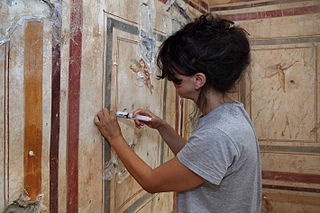
The conservation and restoration of frescoes is the process of caring for and maintaining frescos, and includes documentation, examination, research, and treatment to insure their long-term viability, when desired.

Kashmiri papier-mâché is a handicraft of Kashmir that was brought by Muslims saint Mir Sayyid Ali Hamadani from Persia in the 14th century to medieval India. It is based primarily on paper pulp, and is a richly decorated, colourful artifact; generally in the form of vases, bowls, or cups, boxes, trays, bases of lamps, and many other small objects. These are made in homes, and workshops, in Srinagar, and other parts of the Kashmir Valley, and are marketed primarily within India, although there is a significant international market. The product is protected under the Geographic Indication Act 1999 of Government of India, and was registered by the Controller General of Patents Designs and Trademarks during the period from April 2011 to March 2012 under the title "Kashmir Paper Machie".

The conservation-restoration of Leonardo da Vinci's The Last Supper is an ongoing project that has spanned many centuries. Completed in the late 15th century by the Renaissance artist Leonardo da Vinci, the mural is located in the refectory of the Convent of Santa Maria delle Grazie, Milan, Italy. The Last Supper was commissioned by Ludovico Sforza, Duke of Milan in 1495, as part of a series of renovations to the convent with the intention that the location would become the Sforza family mausoleum. Work began on The Last Supper in 1495 and lasted until 1498. The scene is understood to depict the Bible verse John 13:22, showing the reactions of the Twelve Disciples, at the Last Supper, in the moments following Jesus’s announcement that one among them will betray him.
References
- ↑ Boris Andreevich Uspenski (1976). The Semiotics of the Russian Icon. John Benjamins Publishing. p. 19. ISBN 90-316-0078-4.
- ↑ Bruno Fabbri (2017-06-06). Science and Conservation for Museum Collection. Nardini Editore. p. 339. ISBN 978-88-404-4218-1.
- ↑ "Techniques and materials". British Museum. Retrieved 26 December 2018.